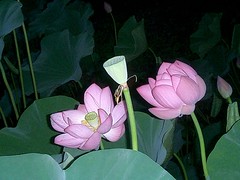The Lotus effect in material science is the observed self-cleaning property found with lotus plants. In some Eastern systems, the lotus plant is a symbol of cleanliness. Although lotuses prefer to grow in muddy rivers and lakes, the leaves remain clean.
Botanists who have studied lotus leaves have found that they have a natural cleaning mechanism.
Their microscopic structure and surface chemistry mean that the leaves never get wet. Rather, water droplets roll off a leaf's surface like mercury, taking mud, tiny insects, and contaminants with them. This is known as the Lotus Effect.
Some nanotechnologists are developing methods to make paints, roof tiles, fabrics and other surfaces that can stay dry and clean themselves in the same way as the lotus leaf. This can usually be achieved by treatment of the surface with a fluorochemical or silicone treatment. It is also possible to achieve such effects by using combinations of polyethylene glycol with glucose and sucrose. A new paint has now been developed which is self cleaning in this way, and even glass panels have been brought onto the market for use on the roofs of conservatories etc.
In one method an aluminium surface is made superhydrophobic by immersing it in sodium hydroxide for several hours followed by spin coating a layer of perfluorononane to a thickness of 2 nanometers. This procedure increases the water contact angle from 67° to 168°, an effect that can be explained by Cassie's law. Electron microscopy shows that the aluminium surface resembles that of a lotus surface with a porous micro structure containing trapped air.

